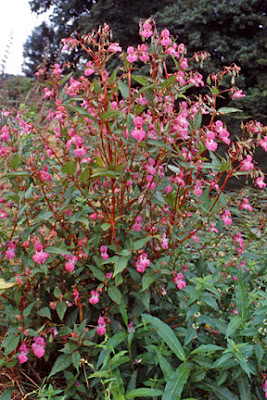WANTED
 |
| Royal Horticultural Society |
Himalayan balsam
(Impatiens glandulifera)
Species description: Large dense
stands of bright pink/purple flowers that often tower over you, reaching heights
of up to 10 ft tall.
Where:
Since 1839, this species has been at large in the UK during the summer months, spotted
along river banks, wasteland and residential gardens. A single
plant can produce up to 800 seeds, helping it spread across the country via wind, water and human activity (Royal Horticultural Society).
Effect on biodiversity and landscape : This plant has a negative impact on species
diversity, and can potentially lead to a 25% reduction in species richness at
sites where it grows. Light sensitive plants are at particular threat from this invasive species.(Hulme and Bremner, 2006).
The
plant is renowned by Bees all over the country for producing a sugar rich nectar at a very rapid rate. Consequently it is preferentially pollinated, enhancing the spread of I. glandulifera whilst having a negative effect on the fitness of native species (Chittkaand Schürkens, 2001)
Additionally, I. glandulifera dies out at the end of summer and
removal of the plant biomass leaves the large areas of empty river banks which
are liable to soil erosion. (Shaw and Tanner, 2008).
In 2013 this invasive species hit national headlines!
Hi Elena,
ReplyDeleteGreat post - I love the wanted ad! I wasn't aware of this invasive species, so thanks for sharing. Check out the London Wildlife Trust's website for their involvement with the control of invasive species including the Himalayan Balsam: http://www.wildlondon.org.uk/habitat-and-species-management
Cheers,
Katherine
Hi Katherine,
ReplyDeleteThanks for the suggestion, it is really interesting to see management of this invasive species in action. You may be surprised to hear that this the Himalayan Balsam is also an invasive species to Canada, and has been present since approximately 1900, here is a link where you can find out more: http://www.shim.bc.ca/invasivespecies/_private/himalayan_balsam.htm
Thanks
Elena
Thanks for sharing! I didn't know that it was also present in Canada, and that it's so widespread there. I'll be keeping an eye out for it next summer!
DeleteI think plant grows along the banks of the canal in a garden that I used to manage. It is quite pretty and the animals seem to like it! The winter die-back is a problem, are there any plants which grow well with it? Do you know if it has any positive feedback - the bees for example? Is anything being done to control it?
ReplyDeleteHey, as far as I can tell there are no plants in the UK which grow well with it...due to a rapid growth rate and high seed production it is a very strong competitor, hence why there is such a large effort to remove the plant from its non-native range. A large number of organisations such at the Royal Horticultural Society, and the Environmental Agency are encouraging people to uproot the plant where it is seen. Additionally some organisations also suggest the use of chemical control but this is often plan B.
DeleteYour question on bees raises an interesting point that I hadn't thought about. After researching it, it appears that the plant may be important for the survival of some colonies where nectar is otherwise limiting. Here’s a statement from the British Beekeepers Association that you might find interesting http://www.himalayanbalsamwales.co.uk/images/himalayan%20balsam.pdf
Elena